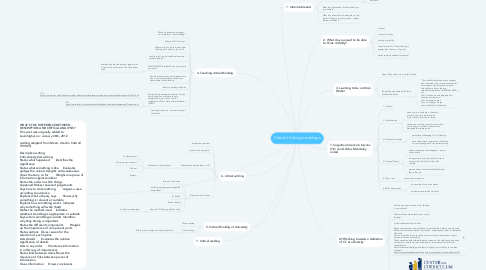
1. WHAT’S THE DIFFERENCE BETWEEN DESCRIPTION AND CRITICAL ANALYSIS? This post was originally added to Learnhigher on: January 26th, 2012 (writing adapted from Moon, cited in Cottrell 1999:23) Descriptive writing Critical/analytical writing States what happened Identifies the significance States what something is like Evaluates (judges the value) strengths and weaknesses Gives the story so far Weighs one piece of information against another States the order in which things happened Makes reasoned judgements Says how to do something Argues a case according to evidence Explains what a theory says Shows why something is relevant or suitable Explains how something works Indicates why something will work (best) Notes the method used Indicates whether something is appropriate or suitable Says when something occurred Identifies why they timing is important States the different components Weighs up the importance of component parts States options GIves reason for the selection of each option Lists details Evaluates the relative significance of details Lists in any order Structures information in order (eg. of importance) States links between items Shows the relevance of links between pieces of information Gives information Draws conclusions
2. 4. Teaching critical thinking
2.1. When do students get taught 'university-level' critical thinking?
2.2. What do YOU do now?
2.3. What could you do to make critical thinking more obvious, less tacit?
2.4. tend to pick it up by intellectual osmosis - tacit knowledge -
2.5. What POSITIVE feedback do you give/have you seen?
2.5.1. explains why the student got higher marks. if you don't and just put a tick, think about that!
2.6. Provide an example question/assessment task in your subject where students can demonstrate critical thinking
2.7. Refer to marking schemes
2.8. Review King's assessment criteria. How (on earth) could you use these to help students be more critical. critical judgement is 90%+ while critical evaluation is 80%+
2.8.1. UG: https://www.kcl.ac.uk/artshums/study/handbook/sguides/assessment/ah-ugmarkingcriteria-updates-july-2017.pdf
2.8.2. PG: https://www.kcl.ac.uk/artshums/study/handbook/sguides/assessment/l7markcrit.pdf
2.9. Learning Outcomes - how do/could you use these?
3. 5. Critical thinking at University
3.1. Critical reading
3.2. Critical writing
3.2.1. Wray? critical reading and writing checklist
4. 6. critical writing
4.1. answer the question!
4.2. what are the key terms?
4.3. What are you being asked to do?
4.3.1. Questions in your subject:
4.3.1.1. To what extent...?
4.3.1.2. Compare and contrast...?
4.3.1.3. Define...?
4.3.1.4. Explain....
4.4. Elements of an answer
4.4.1. Intro and conclusion
4.4.2. building an argument through the assignment
4.4.3. So What?
4.4.4. Sense checker
4.4.5. what are YOU saying about a topic
4.4.5.1. Avoid 'quote hopping'
5. 7. Critical reading
6. 1. Intro/icebreaker
6.1. Critical thinking outside academia? how do we make choices?
6.1.1. evidence
6.1.2. Inference
6.2. What are the features of critical thinking in your subject?
6.3. What role does critical thinking play in your subject? (discuss in small groups - subject based or different?)
7. 8? Working towards a definition of CT at university
7.1. How do you demonstrate critical thinking in your subject?
7.2. What are the common features of critical thinking?
7.3. A well-cultivated critical thinker: Raises vital questions and problems, formulating them clearly and precisely Gathers and assesses relevant information, using abstract ideas to interpret it effectively Comes to well-reasoned conclusions and solutions, testing them against relevant criteria and standards Thinks openmindedly within alternative systems of thought, recognizing and assessing, as needs be, their assumptions, implications, and practical consequences Communicates effectively with others in figuring out solutions to complex problems. https://www.criticalthinking.org/pages/our-conception-of-critical-thinking/411
7.4. Framework of Competencies/Subcompetencies | Center for Curriculum Redesign
8. 2. What do you need to be able to think critically?
8.1. context
8.2. more information
8.3. opinion/originality
8.4. 'lower-level' skills. Critical thinking is greater than the sum of its parts
8.5. ability to weigh evidence/argument
9. 3. Learning to be a critical thinker
9.1. when did you become a critical thinker?
9.2. Empathise with students. Refer to Brookfield's lenses
9.2.1. “The critically reflective process happens when teachers discover and examine their assumptions by viewing their practice through four distinct, though interconnecting lenses’ (Brookfield, 2005 p xiii). Lens of their own autobiography (as teachers and learners) Lens of students' eyes Lens of colleagues’ eyes Lens of educational literature
10. ?. Cognitive Science 6 lessons (Tim van Gelder, Mendeley notes)
10.1. 1. It's hard
10.2. 2. Practice helps
10.2.1. need to do it, and have a chance to practice. Can't just be told to be more critical or learn by imitation
10.2.2. deliberate, conscious practice. know what you're trying to achieve, with activities designed to achieve goals
10.3. 3. Practice for transfer
10.3.1. particularly challenging for Crit Thinking
10.3.2. not a single way to approach it, like there isn't a single approach to problem solving
10.4. 4. Practical Theory
10.4.1. need to understand the language - how to write critically
10.4.2. 2 way process. knowing the discourse of how to write critically can help think critically
10.4.3. practice doesn't automatically follow from theory though
10.5. 5. Map it out
10.5.1. structure an argument
10.6. 6. Belief preservation
10.6.1. an example of cognitive biases
10.6.2. evidence is subservient to belief

